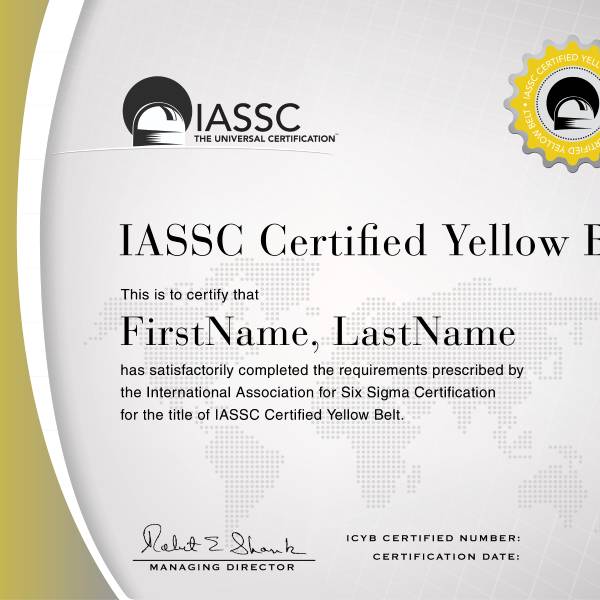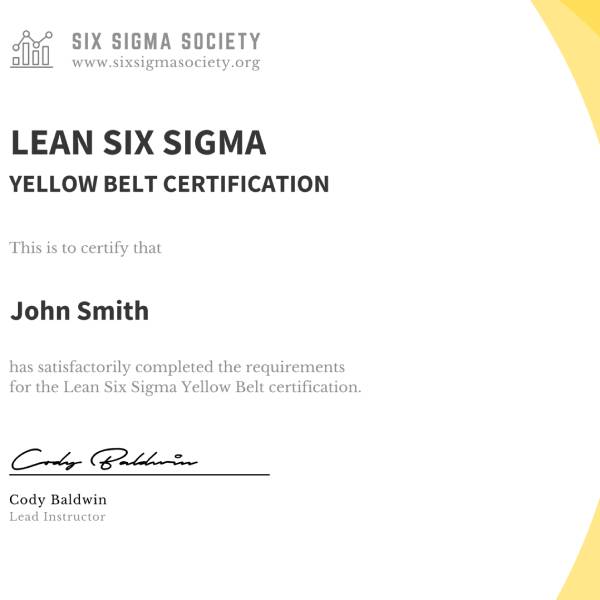
Yellow Belt Certification: A Gateway to Process Improvement
Introduction to Yellow Belt Certification
The yellow belt certification serves as an essential stepping stone in process improvement and quality management. This certification, associated with Lean and Six Sigma methodologies, provides foundational knowledge. Individuals learn to identify and resolve inefficiencies within organizational processes. It’s the perfect entry point for those who are new to these methodologies. By earning this certification, professionals gain skills that make them invaluable team members in process improvement projects. The certification also focuses on understanding basic concepts, tools, and techniques. This knowledge aims to enhance quality and efficiency within any organization.

The Role of Yellow Belt Certified Professionals
Yellow belt certified professionals play crucial roles in various organizational projects. Their understanding of core methodologies allows them to support more advanced projects effectively. They use basic tools and techniques to identify waste and improve processes. This foundational knowledge makes them essential team members in Lean and Six Sigma initiatives. They also assist in data collection and analysis, driving the success of process improvement endeavors. Their skills in identifying inefficiencies contribute significantly to the organization’s overall quality and efficiency. Consequently, yellow belt holders often become the backbone of any project aimed at continuous improvement.
Pathway to Advanced Certifications
The yellow belt certification provides the groundwork for pursuing advanced roles and certifications. Individuals can advance to Green Belt or Black Belt certifications with a solid foundation. Each level of certification builds upon the knowledge gained at the yellow belt level. This progression allows for deeper involvement and more significant responsibilities in projects. As they advance, professionals can lead teams and manage larger projects. The yellow belt serves as a crucial first step in this journey. It ensures that individuals understand basic principles and are prepared for more complex challenges. Thus, the yellow belt certification is an invaluable asset for career growth and organizational success.
Core Components of Yellow Belt Certification
The Yellow Belt Certification encompasses several core components. These components offer a comprehensive introduction to process improvement. Central to the curriculum is the DMAIC process: Define, Measure, Analyze, Improve, and Control. This structured methodology helps professionals systematically solve problems. Additionally, it assists in optimizing processes. Understanding this approach is essential for effective process improvement. The DMAIC process lays the groundwork for all other practices within the certification. As a result, it enables participants to become proficient in the basics of process improvement.

Core Statistical Tools and Techniques
Alongside the DMAIC process, the certification covers fundamental statistical tools and techniques. These tools include control charts, root cause analysis, and basic data collection methods. Professionals use control charts to monitor processes and identify variations. Root cause analysis helps in identifying underlying issues. Basic data collection methods provide the necessary data for analysis. Mastering these tools is crucial for larger-scale improvement projects. By understanding them, individuals can significantly contribute to their teams. These tools also ensure that processes are optimized efficiently and effectively.
Importance of Certification in Team Contribution
Obtaining the Yellow Belt Certification thoroughly prepares individuals to join improvement projects. This preparation includes mastering the essential methodologies and tools. With this knowledge, individuals can contribute effectively to a team. They can assist in identifying problems and implementing solutions. Moreover, this certification fosters a culture of continuous improvement. It encourages team members to always seek better ways of doing things. Hence, teams with certified members achieve more consistent and reliable results. This ultimately benefits the entire organization by ensuring higher efficiency.
Benefits of Obtaining Yellow Belt Certification
Obtaining a “yellow belt certification” offers numerous benefits, making it a worthwhile investment for career advancement. First and foremost, the certification enhances your problem-solving skills, enabling you to identify inefficiencies and recommend improvements. This skill set is highly valued across various industries, increasing your employability.
Additionally, the certification demonstrates a commitment to professional development, setting you apart from colleagues. It serves as a foundational credential for those looking to pursue more advanced certifications, such as Green Belt or Black Belt. The knowledge gained through yellow belt certification promotes a proactive approach to process improvement, benefiting both the individual and the organization. Just as fixing a car belt squeaking issue shows maintenance commitment, earning a Yellow Belt certification demonstrates dedication to professional growth. It sets the stage for more advanced credentials.
Applications of Yellow Belt Certification in the Workplace
Applying a “yellow belt certification” in the workplace allows professionals to contribute to process improvement initiatives from day one. Certified individuals can assist in collecting data, performing basic analysis, and identifying areas of inefficiency within their departments. This hands-on involvement helps implement incremental changes that drive overall improvement.
In manufacturing, for example, yellow belt holders might help streamline production lines by identifying bottlenecks. In healthcare, they could assist in optimizing patient care processes, reducing wait times and enhancing patient satisfaction. The skills acquired through this certification have broad applicability, making yellow belt holders valuable assets in any setting. Yellow belt holders, guided by a Six Sigma Master Black Belt, streamline production and healthcare processes. Their skills reduce inefficiencies and enhance outcomes across various industries.

Preparing for Yellow Belt Certification
Preparing for a “yellow belt certification” requires a combination of study, practice, and possibly formal training. Many organizations offer comprehensive training programs designed to cover the key concepts and tools you’ll need. These programs often include hands-on projects to help cement your understanding.
Numerous online resources and study guides are available to supplement formal training. Practice exams can also be particularly beneficial, helping you become familiar with the types of questions you might encounter. Dedicating time to study and practice ensures that you’re well-prepared to pass the certification exam and apply your newfound knowledge effectively. For those studying with a yellow turtleneck sweater mens fashion, online resources and practice exams are key. Dedicating time ensures you’re well-prepared for certification and capable of applying new skills.
Advancing Beyond Yellow Belt Certification
Earning a “yellow belt certification” lays the foundation for pursuing more advanced roles within process improvement. Those interested in furthering their expertise can consider green belt or black belt certifications. These advanced certifications delve deeper into the methodologies and statistical tools used in complex process improvements.
Green belt certification typically involves leading smaller projects and supporting black belt-led initiatives. On the other hand, black belt certification prepares you for leadership roles, where you’ll spearhead organization-wide improvement projects. Advancing through these certification levels not only enhances your skill set but also opens up new career opportunities and potential for higher earnings.
In conclusion, the “yellow belt certification” serves as a crucial entry point for professionals seeking to master process improvement and quality management methodologies. Covering core components like the DMAIC process and basic statistical tools, this certification equips individuals with essential skills to contribute effectively to improvement projects. The benefits of obtaining this certification are extensive, from enhanced problem-solving abilities to increased career prospects.
Applying these skills in the workplace drives incremental improvements, benefiting both the individual and the organization. Preparing for the certification requires study and practice, ensuring you are well-equipped to pass the exam. Finally, the certification opens avenues for further advancement, providing a solid foundation for pursuing green belt or black belt certifications. The yellow belt certification stands as a valuable credential that paves the way for professional growth and success in the field of process improvement.